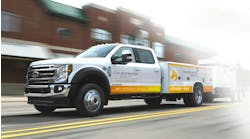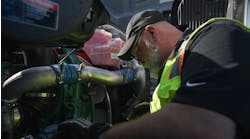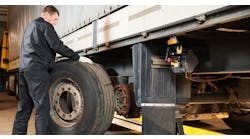Advancements in technology and the rise of the Internet of Things (IoT) are providing fleets with real-time information about their vehicles. Through instantaneous communications and cutting-edge sensor technology, commercial vehicles can work in concert with the Internet to provide a wealth of data related to safety, efficiency and performance. How effective fleets are at collecting, analyzing and interpreting the data will go a long way toward determining how well they can leverage it to improve efficiency and performance, as well as keep their vehicles up and running.
Properly monitoring vehicle and driver performance used to require a significant investment in costly infrastructure and solutions, and interconnected fleet management systems were only economical for large fleet operators due to the high cost of implementation, says Jim Dempsey, national manager, Mobility Partner Development Group, Panasonic, a provider of mobility solutions (www.panasonic.com).
“With the proliferation and rapid development of IoT technology, smaller fleets can now deploy devices and applications that can optimize operations and compete more effectively alongside larger fleets,” he continues. “IoT levels the playing field, as fleets now have low-cost mobility alternatives that can participate on many different networks without having to be a planned part of the system.”
Fleets have the ability to access up-to-date records of an individual vehicle, regardless of its home base, says Jake Schell, product manager, Commercial Vehicle Group, Mitchell 1, a software service provider that specializes in online automotive repair information, vehicle maintenance, automotive diagnostic data and labor estimating solutions (www.mitchell1.com). “What was recorded in a maintenance facility in one location is instantly available in another,” Schell says. “This removes the risk of duplicating maintenance efforts, as well as provides a record of potential ongoing issues as vehicles travel across the country.”
Real-time, contextual data about an asset (i.e. telematics, warranty, service bulletins, preventive maintenance status, detailed build information, service history, etc.) can not only help improve efficiency and downtime, it can also help reduce complexity and stress. While IoT is a key driver of vehicle connectivity, it is far from the only one.
AN ECOSYSTEM OF CONNECTIONS
“It’s not just about IoT,” says Michael Riemer, vice president of products and channel marketing, Decisiv, a provider of Service Relationship Management (SRM) solutions for commercial assets (www.decisiv.com). “It’s about an ecosystem of interconnections -- assets, applications, systems and people across fleets, dealers, OEMs, breakdown/call centers and other service event participants. This combination delivers real value across the entire service supply chain.”
Ultimately, he says, fleets stand to benefit from this ecosystem of connections in the following ways:
- Reduced downtime.
- Improved warranty dollar capture.
- Less rental or safety stock requirements.
- Lower administrative costs.
- More reliable asset planning and utilization.
According to officials at Bosch, a supplier of technology and services (www.bosch.com), connected mobility also presents a wealth of opportunities for fleets to enhance driver safety and comfort through automated driving and driver assistance functions. Technology now enables automatic steering for functions such as lane-keeping assistance and cross-wind compensation. In addition to helping with driver safety and comfort, the officials say it also provides a foundation on the path to fully automated driving.
“Drivers will also benefit from this interconnectivity by having real-time information about where they should stop and take their breaks or stop for the night, based on space availability,” adds Panasonic’s Dempsey.
POTENTIAL CHALLENGES
The rise of vehicle connectivity has presented a number of challenges for fleets, however. While the means to acquire valuable information about commercial vehicles and their operators is readily available, the ability to manage that data and translate it into usable intelligence can be a very difficult undertaking.
“The collection, management and analysis of all the data that an interconnected truck will produce can be overwhelming, requiring specialized tools and training for fleet managers and technicians,” says Panasonic’s Dempsey. “Making sense of the data needs to result in clear, actionable plans that positively improve operational results, otherwise there is little reason to adopt these new technologies.”
Decisiv’s Riemer agrees, saying it’s not enough to simply know that something is happening. Fleets need to put forth a concerted effort to make sure their managers and technicians are tech-savvy enough to interpret the information that is collected. Otherwise, employing one or more IT-specific employees can alleviate this challenge and help maximize the return on the investment in the technology.
“Another primary challenge with connectivity is, if you lose it, you lose it all,” says Dempsey. “It’s really difficult to stay connected on the network when you’re crossing network lines, and that’s where in-cab mobility solutions with enterprise-grade wireless are essential. Fleets that don’t employ rugged mobile devices risk loss of revenue when they are unable to communicate with their trucks and drivers.”
Data security is also a key concern for fleets, and it should not be overlooked, says Wyn Partington, vice president of marketing for NexTraq, a provider of GPS fleet management solutions (www.nextraq.com).
“I think security is an issue, particularly when you consider connected vehicles and driverless vehicles,” he says. “Things are pretty secure over the Internet, but it doesn’t stop people hacking away. There has to be collaboration between companies like ourselves and the OEMs to determine what can be done to a vehicle.”
WHAT THE FUTURE HOLDS
While there are a number of benefits to investing in and employing technology that provides real-time data on a fleet’s vehicles, the trucking industry has been somewhat slow to embrace IoT and vehicle connectivity solutions. Some fleets are utilizing certain offerings in their service bays for predictive maintenance in an effort to make maintenance a strategic or competitive differentiator for them. Others simply look at maintenance as an inevitable and unavoidable part of their business and have not invested in the latest IoT-based monitoring, sensing and alerting maintenance technologies.
Other factors have played a role as well, says Decisiv’s Riemer. They include:
- The aging population of employees and lack of sustainable institutional knowledge.
- Limited access to new talent pools, especially in a generation used to mobile, IoT and other leading technologies.
- A trend toward outsourcing of maintenance based on the technician shortage and ever-increasing complexity of assets.
- More and more data requirements around faster and better decision-making, as well as the continual push to do more with less.
Vehicle connectivity affords fleets the opportunities to enhance driver safety, improve uptime and reduce maintenance-associated costs by giving them more data and insight into their vehicles than ever before. As time passes, more and more vehicles are connected in some form or fashion. However, says Panasonic’s Dempsey, for this level of integration to function as efficiently as possible, the data gathered could be made available to the entire transportation and logistics value chain, improving the overall performance of the industry.
“To maximize the value of this data, development of industry-specific analytics tools will be required,” he adds.
Paul Menig, CEO, Tech-I-M, a provider of consulting services to help companies succeed by leveraging technology in products and processes (www.tech-i-m.com), says he expects the industry to evolve in a similar way to when electronic engines were introduced in the mid-1990s and there was too much data for the industry to process.
“The engineers and designers learned that they need to cut down on the number of fault codes, and they need to do some filtering and testing of the reasonableness of the values,” says Menig. “People’s comfort level with the technology will improve over time. It’ll be an evolution. There will be some issues, but we’ll get used to it.”
Riemer agrees, saying that, as more systems and technologies become connected, fleets will become more adept at making informed and data-based decisions on maintenance and repair events.
“The more you know about the driver, hours of service, issues at hand and all the other information about the asset, a more informed and coordinated process between maintenance and operation will transpire,” he continues. “This will allow maintenance to become a more strategic and valued part of the fleet management hierarchy.”




